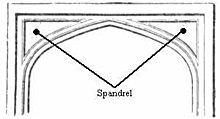Écoinçon


Un écoinçon est un ouvrage de menuiserie ou de maçonnerie formant l'encoignure de l'embrasure d'une baie. Il désigne aussi l'espace compris entre deux arcs ou entre un arc et une délimitation rectangulaire (exemple : alfiz).
Dans le style gothique, on trouve cet élément aux angles des roses ou des rosaces formant des ouvertures de verrières décorées avec des écoinçons ajourés.
Un écoinçon est aussi une partie d'un tapis qui est située aux coins du champ.
Le terme s'emploie aussi pour un fer de reliure destiné à ornementer les coins d'un plat (il existe alors deux fers symétriques, en général).
En biologie
[modifier | modifier le code]La perfection de l'adaptation des décors des écoinçons de la basilique Saint-Marc de Venise à leur configuration architecturale a servi à Stephen J. Gould et Richard C. Lewontin en 1978 d'argument par l'absurde contre l'école adaptationniste, qui dominait à l'époque la biologie de l'évolution, dans un article resté célèbre[1]. C'est cet article qui a transposé pour la première fois le terme « écoinçon » (spandrel en anglais) à la biologie, par erreur car il s'agissait en réalité de pendentifs[2], tandis que le français a fini par préférer celui de trompe.
Notes et références
[modifier | modifier le code]- (en) S. J. Gould et R. C. Lewontin, « The Spandrels of San Marco and the Panglossian Paradigm: A critique of the adaptationist programme », Proceedings of the Royal Society of London. Series B. Biological Sciences, vol. 205, no 1161, , p. 581-598 (ISSN 0080-4649 et 2053-9193, DOI 10.1098/rspb.1979.0086, lire en ligne, consulté le ).
- (en) S. J. Gould, « The exaptive excellence of spandrels as a term and prototype », Proceedings of the National Academy of Sciences, vol. 94, no 20, , p. 10750–10755 (ISSN 0027-8424 et 1091-6490, PMID 11038582, PMCID PMC23474, DOI 10.1073/pnas.94.20.10750, lire en ligne, consulté le ).
Voir aussi
[modifier | modifier le code]Articles connexes
[modifier | modifier le code]Text is available under the CC BY-SA 4.0 license; additional terms may apply.
Images, videos and audio are available under their respective licenses.
